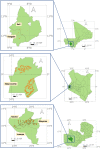Attractive targeted sugar bait phase III trials in Kenya, Mali, and Zambia
- PMID: 35945599
- PMCID: PMC9361277
- DOI: 10.1186/s13063-022-06555-8
Attractive targeted sugar bait phase III trials in Kenya, Mali, and Zambia
Abstract
Background: Long-lasting insecticidal nets (LLINs) and indoor residual spraying (IRS) target night-time indoor biting mosquitoes and effectively reduce malaria transmission in rural settings across Africa, but additional vector control tools are needed to interrupt transmission. Attractive targeted sugar baits (ATSBs) attract and kill mosquitoes, including those biting outdoors. Deployment of ATSBs incorporating the insecticide dinotefuran was associated with major reductions in mosquito density and longevity in Mali. The impact of this promising intervention on malaria transmission and morbidity now needs to be determined in a range of transmission settings.
Methods/design: We will conduct three similar stand-alone, open-label, two-arm, cluster-randomized, controlled trials (cRCTs) in Mali, Kenya, and Zambia to determine the impact of ATSB + universal vector control versus universal vector control alone on clinical malaria. The trials will use a "fried-egg" design, with primary outcomes measured in the core area of each cluster to reduce spill-over effects. All household structures in the ATSB clusters will receive two ATSBs, but the impact will be measured in the core of clusters. Restricted randomization will be used. The primary outcome is clinical malaria incidence among children aged 5-14 years in Mali and 1-14 years in Kenya and Zambia. A key secondary outcome is malaria parasite prevalence across all ages. The trials will include 76 clusters (38 per arm) in Mali and 70 (35 per arm) in each of Kenya and Zambia. The trials are powered to detect a 30% reduction in clinical malaria, requiring a total of 3850 person-years of follow-up in Mali, 1260 person-years in Kenya, and 1610 person-years in Zambia. These sample sizes will be ascertained using two seasonal 8-month cohorts in Mali and two 6-month seasonal cohorts in Zambia. In Kenya, which has year-round transmission, four 6-month cohorts will be used (total 24 months of follow-up). The design allows for one interim analysis in Mali and Zambia and two in Kenya.
Discussion: Strengths of the design include the use of multiple study sites with different transmission patterns and a range of vectors to improve external validity, a large number of clusters within each trial site, restricted randomization, between-cluster separation to minimize contamination between study arms, and an adaptive trial design. Noted threats to internal validity include open-label design, risk of contamination between study arms, risk of imbalance of covariates across study arms, variation in durability of ATSB stations, and potential disruption resulting from the COVID-19 pandemic.
Trial registration: Zambia: ClinicalTrials.gov NCT04800055 . Registered on March 15, 2021 Mali: ClinicalTrials.gov NCT04149119 . Registered on November 4, 2019 Kenya: ClinicalTrials.gov NCT05219565 . Registered on February 2, 2022.
Keywords: Attractive targeted sugar bait; Cluster-randomized controlled trial; Malaria; Vector control.
© 2022. The Author(s).
Conflict of interest statement
The authors declare that they have no competing interests.
Figures



References
Publication types
MeSH terms
Substances
Associated data
Grants and funding
LinkOut - more resources
Full Text Sources
Medical

